Well, it's been a long time since anything really was heard from me, but that actually meant much much time has been spent on it, and from one improvement over the other, any story would have been obsolete before it got posted.
This one too will be obsolete within two weeks, but I didn't want to keep you wait longer, and the phase things are in now is a separate phase anyway (not that the phase itself can be described ... it's juat a "quality" phase, independent from the other stuff).
First, roughly what has been going on lately ...
As some will know I bought the analyser equipment (5 months ago), which I bought for software measuring purposes. However, at that time I felt some better justification for buying at designing and building this DAC, but since the DAC was a kind of coincidence (although planned for some years), I didn't actually use the analyser at that time. That is, not for *creating* the DAC. It was already there in its stage you have seen from the earlier posts in this topic.
In the mean time (and along the way of listening to the DAC, finding its best settings, etc.) the analyser did not bring me what I was hoping for, and urged by the wanting to know what actually happens when software makes things sound different (you know, all being in the "bit perfect domain"), around the time of the last XXHighEnd upgrade I started to write my own analysis software. And although that by itself was planned right from the start of XXHighEnd, I was encouraged by Jeffc who came up with blu ray ripped CDs vs. normal DVDRom etc. drives, and the first sounding better, all files containing the same bits and bytes.
Although I could make something of that rather quickly, it took an inmense amount of time to get it workable for you (because I like to have it within XX), and right at this moment it is not finished. It is not finished because of the results I obtained from it, told me how bad a DAC actually performs ...
From one thing came the other, and where my own software told me "a" behavior of the DAC, I started to use the analyser to look into things better, and right now I couldn't have made a better investment than buying that apparatus.
So, I did the most obvious when an engineer (which I am actually not) wants to know what is going on and ... started to improve.
In between the lines other developments around the DAC were and are on-going, mostly related to seeing better my own wishes after it was playing, and in close co-working with the engineers who help me with this in the first place. And not to forget : I started this DAC project for my own self but got enthusiast by the so many who wanted to buy it, some in DIY mode, for price reasons or other.
Although it may be hard for you to follow, but at the start of my own analysis software, suddenly all came together. I'll try to sum up a few :
a. The engineer, now having designed a four later board, really found that filtering -if to be there at all- should be in software;
b. My measurement of the "old" DAC showed that things could be better in some theoretical areas;
c. The whole design of the "old" DAC was too large. It looks impressive allright, but it would impeed for a steep price;
d. The general idea growing was : speed. Speed speed speed, which means throw out components (also see a);
e. From the original design I learned that jitter is not *the* aspect it is all about, never mind we like to think so;
f. I found that so many options should be in the DAC (not expressed so far), that the price would go up and up;
g. While the latter may be no problem for many, I really want just everyone to enjoy this DAC.
And thus ... while the new DAC board finished yesterday including some heavy programming by the engineer concerned (oh yes, a DAC runs on software too), I finished my own project on getting the whole into a minimalistic design with enough headroom (price) for all I want to have additionally in there, but which turns out to measure as ... well, an oversampling DAC. Not that this went by itself, because it took hundreds of hours of investigating, trying, testing and listening.
In the mean time I can tell you that theoretically the DAC can be full of switches for different sound (all legitimate, because about all I would have been writing screaming stories if I would have had the time), but right now I'll stick to "one sound", which is the one I finished yesterday.
In between the lines, and for understanding : what I have been doing myself is outside the DAC board, and can be considered the analogue stage. So, what I will be writing about below is about that, and the "old" DAC board. Why not the new one ? well, because that will again need all the trimming, and knowing myself it will take another few weeks before I will be able to report about that. But the fun is : it will be better again (not that I can imagine that at this moment).
Right. So now you understand the environmental conditions the next is about, I must emphasize on the importance of what actually happened, which is why the next step (the new DAC board) will be as important for better sound. In the end I mean : this is not theory only, but it is about measurements proving that what you see for better measurements, sounds better indeed. In fact it is *the most* important, because it was never understood why an NOS DAC could sound better while it measured so much worse.
Of course, I have my own explanations to that, which is about the squares vs. the sines and the destroyment of both (the first by OS the second by NOS). However, the net results could be resoned only, and no science could ever show the absolute right. Now, this will all be obsolete when the NOS DAC measures nearly the same as an OS DAC, right ?
Because I want to be longwinded today, I can add that harmonic distortion theoretically is all over in the NOS DAC, knowing that squares (or squareish sounds) create harmonics, *assuming* that the squares we talk about were sines originally. However, nobody knows, looking at the CD data, when a square which is there, was original or not. No matter when it was a sine, it can be a square in digital only, so whether (e.g.) a synthesizer put out a pure square at 22050Hz, or whether it was a pure sine at 22050Hz, in digital it looks exactly the same : a square. Now, when an analyser puts in a sine, and it detects harmonics (2nd, 3rd, 4th, etc.), it tells you : no good ! And the higher those harmonics are, the more no good it is. Now, while this is something we have to live with, during the process I found quite some other parameters influencing these "harmonics" ...
Allright, because I really feel longwinded today, and the chance is fair that you start to fall alseep by now, let's look at a picture from another topic in here, which was about me being bothered by the 17.7KHz frequency a modulating pump throws on my mains and which I could capture my microphone through the loudspeakers :
Already earlier I found that adding noise to the electrical system, would make a peak (and its audible sound !!) like this go higher. Hmm ...
Mind you, this is not an analyser fault, and the picture you see is just from a microphone who captured this sound in front of the speaker, visualized by as program that can show it in real time.
With the pure coincidence of this knowledge (noise let rise such anomalies), at working at the analogue stage of the DAC I could see this stupid thing grow higher or go down, the harmonic distortion of the DAC going along with it. From that point on I knew this was caused by noise, or noisy connections if you want.
In the mean time, also coincidence, I received FFT pictures from the engineer from the measurement of the new DAC board, and THD+N (Total Harmonic Distortion + Noise) which showed such low distortion from the DAC itself, that I got urged to get there too, but now for the whole chain.
Yeah, if you don't know any better, why not be foolish and try it !
Allright, at first I had 60 screenschots to show everything at the various frequencies, but I thought that is really too much, so I'll stick to six for now. All will be better at the definitive version anyway, so more pictures then.
The first of the three pictures below show (all left channel only)
- my old NOS DAC which is considered to be a good one; no oversampling, no filter (orange).
- Phasure NOS1; no oversampling, no filter (red);
- Phasure NOS1; upsampled 4x (which is different from oversampling !), no filter (also red).
10000Hz with low pass filter :The numbers show the Total Harmonic Distortion relative to the amplitude of the base tone (which is a 10000Hz sine here);
Note that the amplitude of the base tone for official test measurement should be at -60dBFS, but that squeezes the picture vertically and things will be harder to see. Also the amplitudes can't start at -0dBFS because the output voltage of both DACs is not normalized (which would be 2VRMS), hence it is less. For both DACs this does not matter for the figures.
You can clearly see that the "Good" NOS DAC is much more wild at the bottom side. Note that the THD+N(oise) figures don't show an avarage, but in fact the worst peak anywhere occurring relative to the frequency band measured. Because the figures shown only take into account the normal audio band, this will be those first two peaks to the right of the 10000Hz original tone, topping -120dB, the original tone being at -40dB. So, the distortion is at -80dB relative to the original tone.
Note that these are aliasing residues (the mirror being at 22050 Hz), and not harmonics.
If you compare the first picture with the second, you can notice some 10dB of difference between the general noise floors in both pictures.
Of course it is very clear that the first picture looks much worse, and never mind the distortion figure (remember, which is about the peaks), much more harmonic distortion is present in the first picture.
On to the last picture; this shows what happens when the DAC upsamples the original data 4 times (so, from 44.1 to 176.4 in this case), and that this prevents the aliasing, or in other words the distortion at the left side of the Nyquist mirror. However, because aliasing also takes place at the right side of the mirror, there too all the sh*t has vanished.
To get the grasp of another kind of leage, below are the same pictures again (but it were separate takes), but now the distortion figure reflects more than the audio band (in this case, up to 96KHz). Aha, those figures really show different now :
10000Hz no low pass filter :Now, while keeping in mind that the "Good DAC" really is a good DAC, and not any worst example to, say, proove the NOS1 can do better, you can see that the difference emerges by the upsampling. Ehh, but wait a minute, wasn't the NOS about "non oversampling" ? True, true ...
The whole point is, that oversampling, like any sigma-delta DAC would do (and then I mean times 64 to times 256) is killing the squares, while 4 times upsampling shifts away the Nyquist mirror, removing the distortion in the audible band *and* outside it, the latter being bad for your amplifier, which might not be able to cope with it. And now it comes : where the OS DAC can't do without the heavy oversampling because otherwise it can't operate, the NOS DAC can upsample to any rate we think is necessary
if it can do that in the first place. And this is where 24/192 comes in as an important phenomenon, because the Good DAC just can't do that. So, now you also know why I did not show any picture of the Good DAC without all that distortion, because it just can't do the upsampling ... (mind you, some DAC chips can, but they are not 24 bits).
In the end, while this is achieved as a basis feature, you can see (at understanding all a little) that no filter is needed in order to get those nasty fake harmonics down, because they are way shifted out of the audible band, and even up to a region where your amplifier may not be bothered by it anymore (which is above 176.4KHz in this case).
Going further again, we are thus comparing a "nice and easy" DAC (which can do 18/96 in this case) with a crazily more complicated 24/192 DAC for which it is not so easy at all to achieve the same good figures. That is, the DAC chip itself can do it allright, but the analogue stage behind it must be able to do too, just like your amplifier must be able to cope with higher frequencies in order to perceive them right. And it is this where the tweaks were applied ... wrong ... where they *had* to be applied, in order to achieve a same sound quality a good NOS DAC with lower sample rate and bit depth, well, can't to begin with. So, now we are confused ...
The confusement starts by looking at the OS DAC chip, which can reach so called very good THD+N levels, which
a. are true when sines are assumed to get in as the only kind of wave
b. are not true for reality because the analogue stage is needed just the same, but since everything which is squareish in the first place is destroyed within the DAC itself, we will not be able to measure the net results at the end of the analogue stage of the DAC.
Also to keep in mind : any squareish wave requires more speed from the analogue stage because a square is "transient" by nature, while a sine is, well, a nice soft and easy thing.
Now, on to the real merits, what you saw in brief in the pictures above, for both DACs it includes the analogue stage including 2 meters of interlink cable, while for the NOS1 also an analogue volume was included in those measurements (

).
For the "Good DAC" this is not sufficient to drive a main amp at that cable length, while for the NOS1 it is. This means that when it were for measurements and figures only, this all looks good (this can't be shown by these few pictures only, but trust me for now that the other 60 or so pictures proove that, and keep in mind that it will get better only with the new DAC board).
Last on this subject, and actually the most important, is that where the tweaks by itself were necessary to obtain good measurement results (which I think are important), the
reason for the tweaks has been the speed of the analogue section and the means I got there. These means can well be called "illegal" for an engineering point of view, only meaning that no engineer would ever have tried what I did to begin with, and while the job has been tough, together with measurements it got me exactly where I wanted. So, those figures mean much more than only good figures : they tell that a not understood means of arranging an anologue stage with enough drive to directly drive a main amp, just works.
What the pictures can't show is how it sounds.For me, this is is relative to how it sounded before the tweaking, and well, when you hear this for the first time, you won't believe what you are hearing.
The first thing is, that this is completely fluid. Second is that this is completely quiet (call that blackness). Third is that it is in a fashion of balance and easy only an OS DAC can show. Fourth is that the level of detail is unheard. Let the fifth be that this sucks and sucks and sucks you into the music.
The fourth, the level of detail, is the most interesting, and in the end the most important I think. The point here is, it is not difficult at all to "create" detail, but usually this occurs in the higher frequencies, and most often it appears to be fake (harmonics !) afterwards. Mind you, not always, because when I wrote the story like this the first time (never posted), it was as good IMO, but lacked the overall balance, and in the end the all over smashing cymbals did not allow for background music. The most interesting though, and since I think it was as good, it might well become a switch in the DAC (very easy to setup different "sound" arrangements). However ... the version of which I think is final (the one I am listening to right now) has another feature : unveil details at the lower frequencies just because the smashing higher frequencies are *not* there. Things like background voices never heard before, singing saws, wowing guitars while no guitar ever was there before, and in the end you could say that the quitness allows for hearing this all. Keep in mind though : creating quietness also is easy : just get out all the detail and you are *there* too. But hey ...
You must be warned a bit; for me it is rather easy to hear that once you stuff in your favorite preamp, all detail will be lost. Yes, so super-fine all is now. I mean, there is no way anymore that a preamp could make your sound less harsh. It just isn't harsh to begin with, so everything flattening will destroy the detail. But then the DAC can drive your main amp, and it contains a volume control ... (of a means I'm sure it's not applied so far

). And no, this isn't supposed anything like a preamp as you might expect, so don't ask for analogue inputs.
One last thing for now;
There won't be anything left for DIY I think. All is SMD stuff (this is about resistors and all of 2mm wide) but also there won't be much price reason left to want this. Although at this moment I can't tell what prices will be, it will be quite affordable I'm sure. Besides, because everything will be about the most special trimming, grounding, wireing and all, destroying sound instead of bettering is the most likely. Different options for more or less valid sound quality will be in there as far as they don't destroy general SQ to begin with, and filtering options will be by means of (player) software, and uploadable to the DAC in a later stage. This latter is a subject by itself, and will be an option to apply to your choice. Later more about that.
Within the next two weeks I hope to tell more about "the DAC" as a whole, and about how the NOS1 from then on will set a reference for music playback through loudspeakers for once and for all. At least that is where my intentions are.
Right now I am the most satisfied as it is. However, I anticipate on you wanting more.
Peter (who didn't check for typos nor inconsistencies because of changing this little story a couple of times, and which really took him a whole day to write this, and of which he hopes it is a little informative afterall)



 ).
).

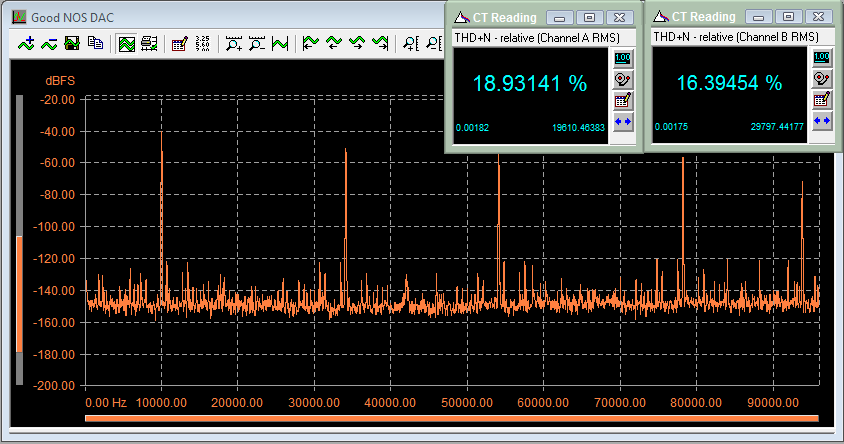
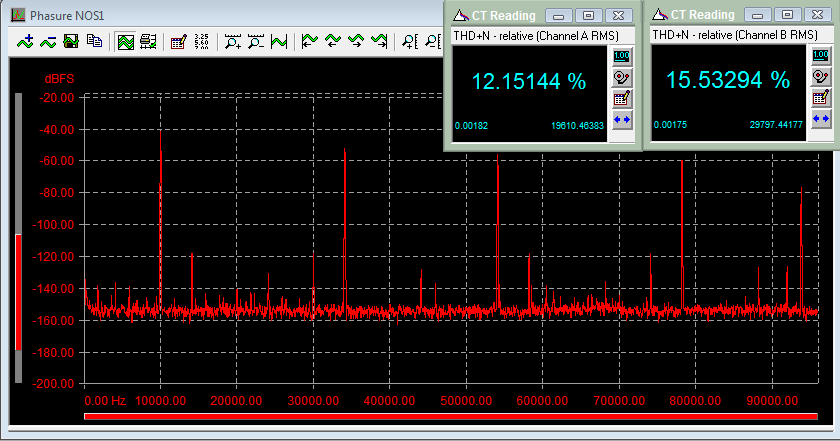
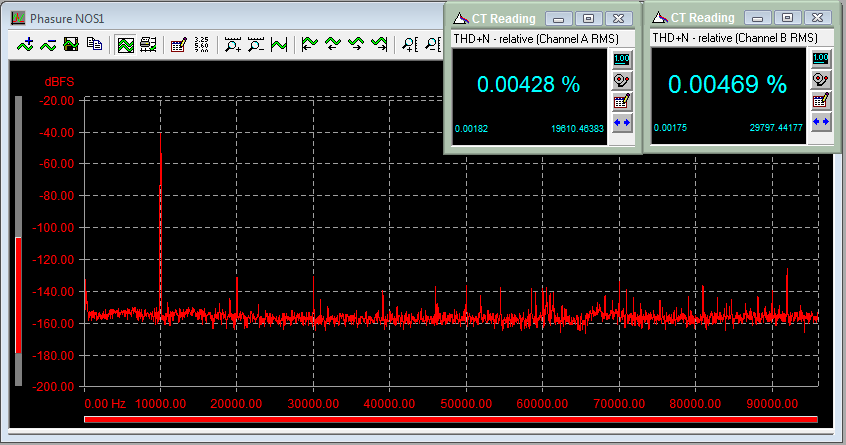
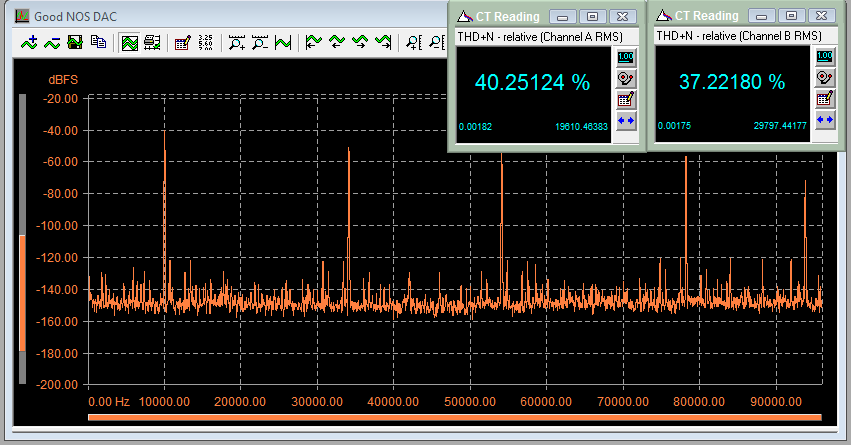
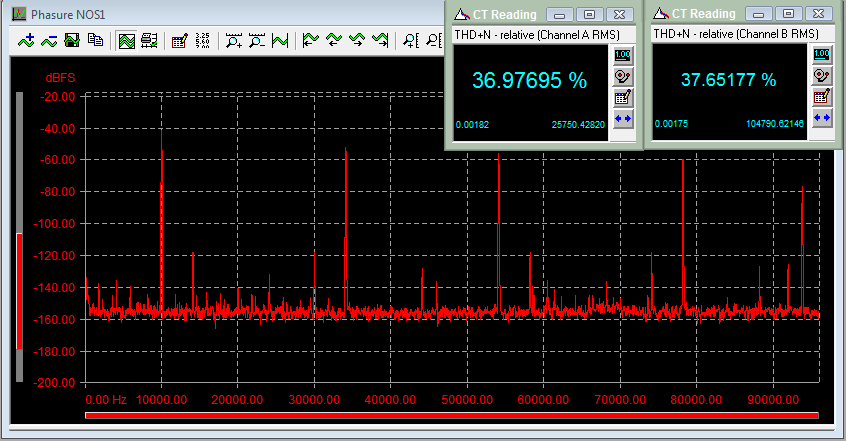
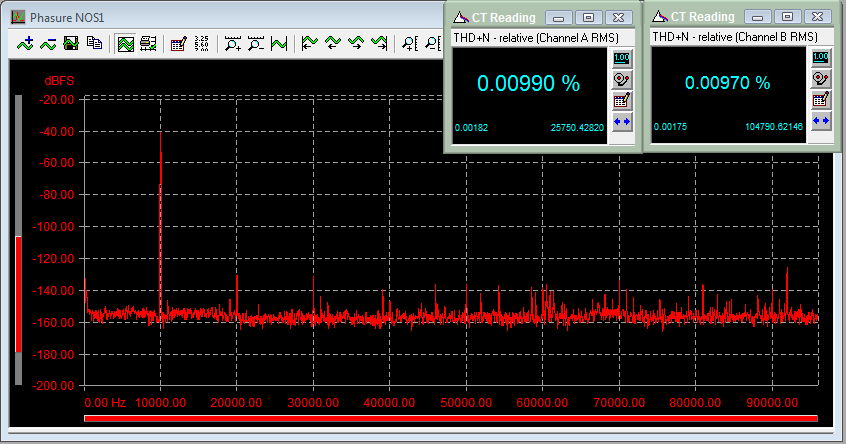
 ).
).